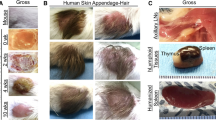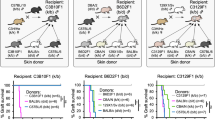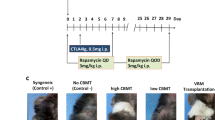Abstract
CERTAIN inbred mice, lethally irradiated and inoculated with bone marrow and spleen cells from F1 hybrids, reject donor-strain skin grafts although they are permanent haemopoietic chimaeras1–3. After rejection their serum is specifically cytotoxic in vitro for donor-strain epidermal cells but not lymphoid cells4, and their leukocytes are stimulated specifically in mixed cultures by donor-strain epidermal cells but not leukocytes5. Thus epidermal cells contain distinctive surface alloantigens (skin-specific or ‘Sk’ alloantigens) which have been suggested to function in vivo as histocompatibility antigens. If this is correct, the rejection of donor-strain skin grafts by persistent chimaeras could be explained as a loss of ‘self-tolerance’ to donor-strain Sk antigens by grafted haemopoietic cells as they proliferate in allogeneic recipients in the absence of these antigens1,2. This interpretation is strengthened because donor-strain skin grafts are not rejected if radiation chimaeras receive donor-strain Sk antigen in the form of epidermal cell suspensions at the time of marrow restoration and thereafter6.
This is a preview of subscription content, access via your institution
Access options
Subscribe to this journal
Receive 51 print issues and online access
$199.00 per year
only $3.90 per issue
Buy this article
- Purchase on Springer Link
- Instant access to full article PDF
Prices may be subject to local taxes which are calculated during checkout
Similar content being viewed by others
References
Boyse, E. A., Lance, E. M., Carswell, E. A., Cooper, S., and Old, L. J., Nature, 227, 901 (1970).
Lance, E. M., Boyse, E. A., Cooper, S., and Carswell, E. A., Transplant. Proc., 3, 864 (1971).
van Bekkum, D. W., and Roodenburg, J., Transplanta. Proc., 5, 881 (1973).
Scheid, M., Boyse, E. A., Carswell, E. A., and Old, L. J., J. exp. Med., 135, 938 (1972).
Gilette, R. W., Cooper, S., and Lance, E. M., Immunology, 23, 769 (1972).
Boyse, E. A., Carswell, E. A., Scheid, M. P., and Old, L. J., Nature, 244, 441 (1973).
Fulmer, R. I., Cramer, A. T., Liebelt, R. A., and Liebelt, A. G., Am. J. Anat., 113, 273 (1963).
Warren, R. P., Lofgreen, J. S., and Steinmuller, D., Transplant. Proc., 5, 717 (1973).
Warren, R. P., Lofgreen, J. S., and Steinmuller, D., Transplant, 16, 458, (1973).
Cho, S. I., Marcus, F. S., and Kountz, S. L., Transplantation, 13, 486 (1972).
Salyer, K. E., and Kyger, E. R., Plastic Reconst. Surg., 51, 672 (1973).
Billingham, R. E., in Transplantation of Tissues and Cells (edit. by Billingham, R. E., and Silvers, W. K.), 1 (Wistar Institute Press, Philadelphia, 1961).
Corry, R. J., Winn, H. J., and Russell, P. S., Transplantation, 16, 343 (1973).
Goldberg, E., Boyse, E. A., Scheid, M., and Bennett, D., Nature, 238, 55 (1972).
John, M., Carswell, E., Boyse, E. A., and Alexander, G., Nature, 238, 57 (1972).
Litchfield, J. T., jun., J. Pharmacol. exp. Therapy., 97, 339 (1949).
Author information
Authors and Affiliations
Rights and permissions
About this article
Cite this article
STEINMULLER, D., LOFGREEN, J. Differential survival of skin and heart allografts in radiation chimaeras provides further evidence for Sk histocompatibility antigen. Nature 248, 796–797 (1974). https://doi.org/10.1038/248796a0
Received:
Revised:
Issue Date:
DOI: https://doi.org/10.1038/248796a0
This article is cited by
-
Skin Immunology and Rejection in VCA and Organ Transplantation
Current Transplantation Reports (2020)
-
Specific reactivity of cyclophosphamide-induced semiallogeneic chimeras
Bulletin of Experimental Biology and Medicine (1987)
-
An immunogenetic analysis of skn antigens in mice
Immunogenetics (1981)
-
Strong and weak immune responses across the same major histocompatibility barrier in rats
Immunogenetics (1978)
Comments
By submitting a comment you agree to abide by our Terms and Community Guidelines. If you find something abusive or that does not comply with our terms or guidelines please flag it as inappropriate.



